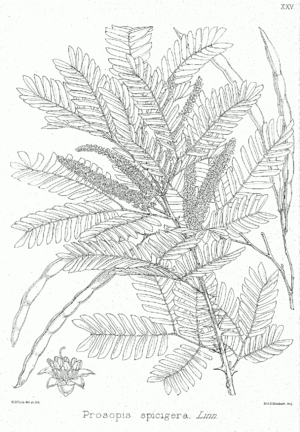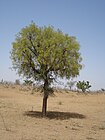Note: This is a project under development. The articles on this wiki are just being initiated and broadly incomplete. You can Help creating new pages.
Difference between revisions of "Prosopis cineraria - Indian mesquite"
m (Prabhakar moved page Prosopis spicigera to Prosopis spicigera - Indian mesquite) |
|||
| Line 1: | Line 1: | ||
| − | + | [[File:Prosopis cineraria Bra25.png|thumb|right|''Shami'', ''Prosopis cineraria'']] | |
| + | '''Shami''' is a moderate sized throny tree with bipinnate leaves distributed from Iran to India. Within India, it is found in the dry and arid regions on the alluvial plains. | ||
| + | |||
| + | ==Uses==, | ||
| + | {{Uses|Skin diseases}}, {{Uses|Cysts and tumours}}, {{Uses|Cough}}, {{Uses|Bronchitis and Asthma}}, {{Uses|Piles}}, {{Uses|Dysentery}}, {{Uses|Diarrhea}} | ||
| + | <ref name="Uses"/> | ||
| + | |||
| + | ==Parts Used== | ||
| + | {{Parts Used|Bark}}, {{Parts Used|Fruits}} | ||
| + | |||
| + | ==Chemical Composition== | ||
| + | |||
| + | ==Common names== | ||
| + | {{Common names|kn=banni mara, perumbe|ml=paramba|sa=Shami, shiva, lakshmi ,mangalya, shankhuphala, Saktuphala, |ta=parambai, Vanni, kulivam, tamali|te=Jammi, priyadarshini, chamee|hi=khejri, sami, chonkar, jhand|en=Shami tree}} | ||
| + | <ref name="Common names"/> | ||
| + | |||
| + | ==Properties== | ||
| + | Reference: Dravya - Substance, Rasa - Taste, Guna - Qualities, Veerya - Potency, Vipaka - Post-digesion effect, Karma - Pharmacological activity, Prabhava - Therepeutics. | ||
| + | ===Dravya=== | ||
| + | |||
| + | ===Rasa=== | ||
| + | Kashaya (AStringent), Madhura (Sweet) | ||
| + | ===Guna=== | ||
| + | Laghu (Light), Rooksha (Dry) | ||
| + | ===Veerya=== | ||
| + | Sheeta (cold) | ||
| + | ===Vipaka=== | ||
| + | Katu (Pungent) | ||
| + | |||
| + | ===Karma=== | ||
| + | Pitta, Kapha | ||
| + | ===Prabhava=== | ||
| + | |||
| + | ==Habit== | ||
| + | {{Habit|Tree}} | ||
| + | |||
| + | ==Identification== | ||
| + | ===Leaf=== | ||
| + | {{Leaf|Bipinnate|alternate|Leaves 1-3-jugate, glabrous or puberulous; petiole and rachis 0.5-4 cm long, the pinnae 2-7 cm long; leaflets 7-14-jugate, ovate, straight to subfalcate, without nerves (or 2-4-nerved at base, the midrib excentric), mucronate, 4-15 mm long x 2-4.5 mm broad, greyish when dry; stipules foliaceous, deciduous. }}<ref name="Leaf"/> | ||
| + | |||
| + | ===Flower=== | ||
| + | {{Flower|Bisexual|spiciform racemes|Pale yellow|| 5-13 cm long, several together, subpaniculate; peduncle with amplexicaul bract (or 2 bracts united), this caducous and leaving an oblique scar, 1.5-2 mm long; bractlets ovate, sessile, 0.5-0.8 mm long, caducous; pedicels 0.5 mm, to 1.5 mm long when mature; flowers yellow, glabrous; calyx truncate, 0.8-1.2 mm long; corolla 3.5 mm long, glabrous, the petals rolled back in age; anthers 0.8-1 mm long; pistil | ||
| + | glabrous. }} | ||
| + | |||
| + | ===Fruit=== | ||
| + | {{Fruit|A Pod|8 - 9 cm long|Fruit slender, elongate, 8-19 cm long (including the stipe 0.8-2 cm), subcylindric-torulose, 4-7 mm in diameter, glabrous; pericarp thin, brittle; endocarp segments thin, longitudinal, little developed; seeds distant, longitudinal, ovate, 6 mm long, the tegument with open horse-shoe fissural line on faces, 10-15 in a pod, brown.|seeds 6-15, 8-10 x 7-9 mm, glossy, red|}} | ||
| + | |||
| + | ===Other features=== | ||
| + | |||
| + | ==List of Ayurvedic medicine in which the herb is used== | ||
| + | |||
| + | |||
| + | ==Where to get the saplings== | ||
| + | ==Mode of Propagation== | ||
| + | {{Propagation|Seeds}}, {{Propagation|Cuttings}}. | ||
| + | |||
| + | ==How to plant/cultivate== | ||
| + | |||
| + | |||
| + | ===Season to grow=== | ||
| + | |||
| + | ===Soil type=== | ||
| + | |||
| + | |||
| + | ===Propagation=== | ||
| + | |||
| + | ==Commonly seen growing in areas== | ||
| + | {{Commonly seen|Tropical area}}. | ||
| + | |||
| + | ==Photo Gallery== | ||
| + | <gallery class="left" caption="" widths="140px" heights="140px"> | ||
| + | File:Khejri.jpg | ||
| + | |||
| + | |||
| + | </gallery> | ||
| + | |||
| + | ==References== | ||
| + | |||
| + | <references> | ||
| + | <ref name="Uses">https://www.ayurvitewellness.com/3499/shami-prosopis-cineraria/ "Uses"]</ref> | ||
| + | |||
| + | <ref name="Leaf">[http://FLOWERING PLANTS OF KERALA VER.2, N. Sasidharan "BOTANIC DESCRIPTION"]</ref> | ||
| + | <ref name="Common names">[http://envis.frlht.org/bot_search "Vernacular names"]</ref> | ||
| + | |||
| + | |||
| + | </references> | ||
| + | |||
| + | ==External Links== | ||
| + | * http://vikaspedia.in/agriculture/crop-production/package-of-practices/medicinal-and-aromatic-plants/prosopis-cineraria | ||
| + | * http://www.worldagroforestry.org/treedb/AFTPDFS/Prosopis_cineraria.PDF | ||
| + | * http://tropical.theferns.info/viewtropical.php?id=Prosopis+cineraria | ||
[[Category:Herbs]] | [[Category:Herbs]] | ||
| + | [[Category:Trees]] | ||
Revision as of 11:20, 16 April 2019
Shami is a moderate sized throny tree with bipinnate leaves distributed from Iran to India. Within India, it is found in the dry and arid regions on the alluvial plains.
==Uses==,
Skin diseases, Cysts and tumours, Cough, Bronchitis and Asthma, Piles, Dysentery, Diarrhea
[1]
Contents
- 1 Parts Used
- 2 Chemical Composition
- 3 Common names
- 4 Properties
- 5 Habit
- 6 Identification
- 7 List of Ayurvedic medicine in which the herb is used
- 8 Where to get the saplings
- 9 Mode of Propagation
- 10 How to plant/cultivate
- 11 Commonly seen growing in areas
- 12 Photo Gallery
- 13 References
- 14 External Links
Parts Used
Chemical Composition
Common names
| Language | Common name |
|---|---|
| Kannada | banni mara, perumbe |
| Hindi | khejri, sami, chonkar, jhand |
| Malayalam | paramba |
| Tamil | parambai, Vanni, kulivam, tamali |
| Telugu | Jammi, priyadarshini, chamee |
| Marathi | NA |
| Gujarathi | NA |
| Punjabi | NA |
| Kashmiri | NA |
| Sanskrit | Shami, shiva, lakshmi ,mangalya, shankhuphala, Saktuphala, |
| English | Shami tree |
Properties
Reference: Dravya - Substance, Rasa - Taste, Guna - Qualities, Veerya - Potency, Vipaka - Post-digesion effect, Karma - Pharmacological activity, Prabhava - Therepeutics.
Dravya
Rasa
Kashaya (AStringent), Madhura (Sweet)
Guna
Laghu (Light), Rooksha (Dry)
Veerya
Sheeta (cold)
Vipaka
Katu (Pungent)
Karma
Pitta, Kapha
Prabhava
Habit
Identification
Leaf
| Kind | Shape | Feature |
|---|---|---|
| Bipinnate | alternate | Leaves 1-3-jugate, glabrous or puberulous; petiole and rachis 0.5-4 cm long, the pinnae 2-7 cm long; leaflets 7-14-jugate, ovate, straight to subfalcate, without nerves (or 2-4-nerved at base, the midrib excentric), mucronate, 4-15 mm long x 2-4.5 mm broad, greyish when dry; stipules foliaceous, deciduous. |
Flower
| Type | Size | Color and composition | Stamen | More information |
|---|---|---|---|---|
| Bisexual | spiciform racemes | Pale yellow | 5-13 cm long, several together, subpaniculate; peduncle with amplexicaul bract (or 2 bracts united), this caducous and leaving an oblique scar, 1.5-2 mm long; bractlets ovate, sessile, 0.5-0.8 mm long, caducous; pedicels 0.5 mm, to 1.5 mm long when mature; flowers yellow, glabrous; calyx truncate, 0.8-1.2 mm long; corolla 3.5 mm long, glabrous, the petals rolled back in age; anthers 0.8-1 mm long; pistil
glabrous. |
Fruit
| Type | Size | Mass | Appearance | Seeds | More information |
|---|---|---|---|---|---|
| A Pod | 8 - 9 cm long | Fruit slender, elongate, 8-19 cm long (including the stipe 0.8-2 cm), subcylindric-torulose, 4-7 mm in diameter, glabrous; pericarp thin, brittle; endocarp segments thin, longitudinal, little developed; seeds distant, longitudinal, ovate, 6 mm long, the tegument with open horse-shoe fissural line on faces, 10-15 in a pod, brown. | seeds 6-15, 8-10 x 7-9 mm, glossy, red | {{{6}}} |
Other features
List of Ayurvedic medicine in which the herb is used
Where to get the saplings
Mode of Propagation
How to plant/cultivate
Season to grow
Soil type
Propagation
Commonly seen growing in areas
Photo Gallery
References
External Links
Categories:
- Ayurvedic Herbs known to be helpful to treat Skin diseases
- Ayurvedic Herbs known to be helpful to treat Cysts and tumours
- Ayurvedic Herbs known to be helpful to treat Cough
- Ayurvedic Herbs known to be helpful to treat Bronchitis and Asthma
- Ayurvedic Herbs known to be helpful to treat Piles
- Ayurvedic Herbs known to be helpful to treat Dysentery
- Ayurvedic Herbs known to be helpful to treat Diarrhea
- Herbs with Bark used in medicine
- Herbs with Fruits used in medicine
- Herbs with common name in Kannada
- Herbs with common name in Hindi
- Herbs with common name in Malayalam
- Herbs with common name in Tamil
- Herbs with common name in Telugu
- Herbs with common name in Sanskrit
- Herbs with common name in English
- Habit - Tree
- Index of Plants which can be propagated by Seeds
- Index of Plants which can be propagated by Cuttings
- Herbs that are commonly seen in the region of Tropical area
- Herbs
- Trees

